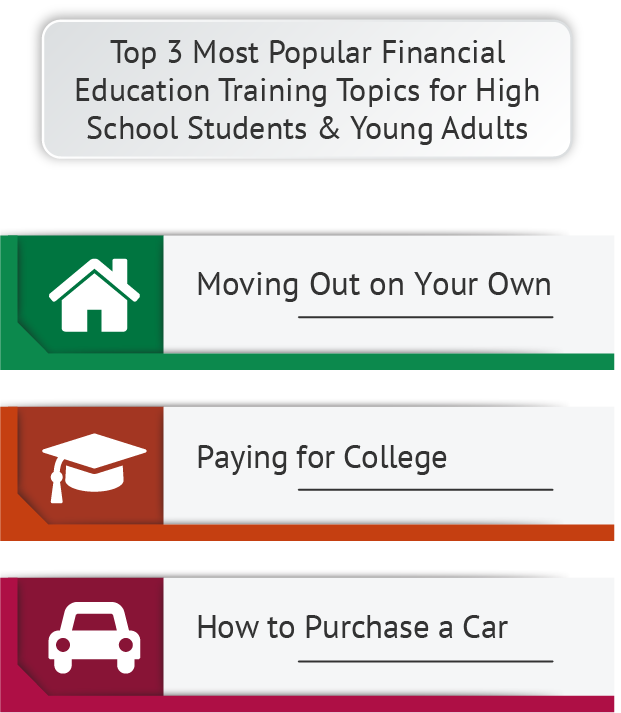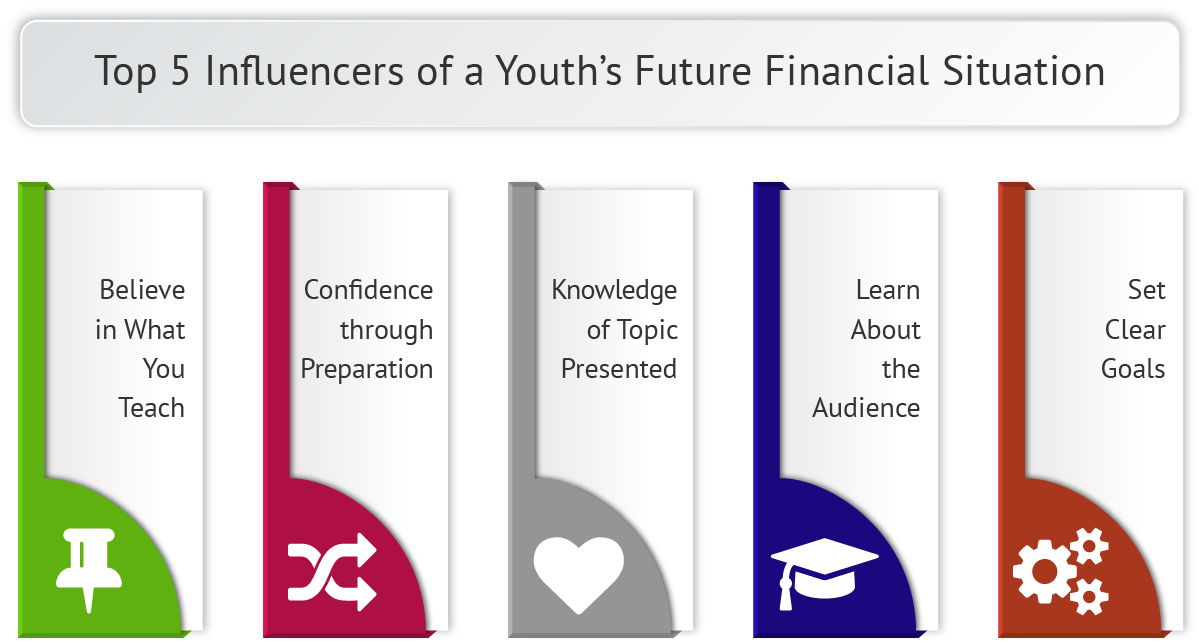The National Financial Educators Council provides public and private schools with turnkey solutions to their financial literacy program needs. This package helps educators achieve measurable improvement in their students’ financial capabilities, while also making progress toward their overall school goals.
The school package is built around three core pillars: education, awareness, and sustainability (funding). These three pillars work together to make a lasting difference in the lives of students, their families, and your faculty.
The NFEC’s financial education package for schools (PK – 12th Grade) can be leveraged to raise funds, garner community recognition, and gain volunteer support while you give students an important financial education.
Read Financial Education Schools case studies – click here.
Youth Financial Illiteracy Solution
Financial problems encountered in youth often impact a person’s life well into the future. Currently financial issues are the leading reason why students drop out of college; and the stress associated with monetary worries inhibits one’s ability to learn. The financial illiteracy epidemic hurts not only our youth, but the whole community.
This turnkey financial education system is designed to empower students with the information they need to confidently navigate the financial real world. The package reduces the time, expense, and personnel required to launch a personal finance program. The system provides everything you need to expand or start a financial education program.
Financial Education
The National Financial Educators Council is an independent education company not affiliated with any financial institution or other sponsor. The financial literacy curriculum, presentations, training, and resources are 100% educational in nature. The package includes:
Presentations & Financial Literacy Curriculum. The presentations align with core educational standards while remaining engaging and fun. The financial literacy curriculum has been widely recognized for its ability to connect with students and inspire them to take positive action to improve their financial situations.
The financial literacy lesson plans are modular in nature to accommodate a variety of classroom and afterschool program schedules. Specialized curriculum is available for PK-K, 1st – 3rd Grade, 4th – 6th Grade, Middle School, and High School.
The material was developed in consultation with the NFEC’s Curriculum Advisory Board, comprised of educators, financial professionals, and financial education experts. The resulting personal finance coursework successfully bridges the gap between theory-based education and practical application.
Certified Financial Education Instructors and/or Presenters. Schools can choose to have staff complete the Certified Financial Education Instructor (CFEI) training or bring in guest speakers from the NFEC’s Personal Finance Speakers Association.
The CFEI professional development course teaches educators how to teach financial literacy instruction effectively. Graduates report greater confidence teaching the subject matter, which improves results and student feedback.
The Certification course is approved by the Certified Financial Planner Board of Standards and is taught statewide through Penn State Erie, the Behrend College and other Universities. These credentials add credibility to educators and the school as qualified to present personal finance coursework.
Upon completion of the 15- to 20-hour coursework, Certified Financial Education Instructors receive a custom graduation certificate and logo for marketing purposes. They also become eligible for membership in the NFEC’s Personal Finance Speakers Association—the first national speakers association for financial educators.
Other Educational Resources. The NFEC has more than 80 financial literacy assets that can be deployed in schools. These assets include special events, virtual live training, games, online learning centers, simulators, project-based learning activities, and other resources that support financial education.
One of the more popular resources is the financial education program for teachers, the Road to Retirement program. Many educators are interested in planning for a secure future, yet lack knowledge. This workshop series leads them through the process of creating their own personal financial plan, and provides the education they need to make capable financial decisions. Educating teachers about their personal finances complements the student programming.
Parental and Community Involvement
Raising awareness about the financial education initiative among parents and the general community can improve overall program results. Schools can increase parent involvement in the learning process, attract volunteers and potential funding opportunities, and build community connections.
The NFEC provides schools with turnkey promotional material for developing sustainable financial education outreach initiatives that help them accomplish funding and education objectives.
Included in the package:
- Parent Outreach Material. Receive financial literacy giveaways for families to build connections and top-of-mind awareness among your students’ parents. Showcase your dedication to helping students pick up life-changing money management skills while providing educational materials to help parents improve their financial situations too.
- Collaboration Tools. Extend your reach and influence through collaborative partner relationships. Attract organizations that can add value to the overall personal finance programming.
- Marketing Package. The NFEC provides promotional tools to help you conduct effective outreach campaigns. This includes fliers, brochures, letters, and electronic messages.
- Media Awareness Material. Receive a comprehensive media package to help raise awareness on campus and within your community.
Program Funding & Sustainability
Monetary support helps expand the reach and impact of your school’s financial education program. For schools that seek funding, this turnkey package offers attractive benefits to companies and foundations that wish to connect with youth.
Receive material that can help you secure funding for your money management program. You will receive:
- Sponsorship Forms. Companies have a vested interest in supporting financial education programs. Receive the sponsorship forms and communication tools you need to connect with possible donors.
*The NFEC does not allow funds to come from credit card companies, high-rate lenders, or any organizations that does not have the best interest of students in mind. Sponsors must provide a positive benefit for students and must be pre-approved.
- Grant Guide. The NFEC’s testing and longer-term measurements deliver empirical data that your organization can leverage to raise support through grants and other funding streams.
- SavingsFund Fundraiser. SavingsFund teaches families the importance of saving early while also delivering financial education. SavingsFund offers a platform you can use to raise money for your school.
- Private Schools. Implementing a financial literacy program increases the value your school offers. Such visibility can build enrollment and improve student and family satisfaction with your institution.
School Financial Education Program Re-cap
The NFEC provides all the material a school needs to implement a comprehensive financial education program. Students gain essential life skills that can have a lasting impact on their lives, while schools meet their organizational objectives.
Contact us now to learn about the turnkey packages that best align with your organization’s objectives.
When they Promote Financial Literacy Schools Win
There’s no question that today’s youth will benefit greatly from learning about money. But fewer people are aware that when they teach financial literacy schools receive multiple benefits too. When kids gain the skills they need to thrive in the real world, they bring positive attention to the school and community.
The main objective in presenting financial literacy for high school students should be preparing youth for the financial real world before they go off to college, trade school, or employment. Many youth today will be overloaded with student and credit card debt and have zero balances in their savings accounts by the time they reach 40. And this sad trend is occurring at a time when Social Security benefits are likely to be gone—or at least greatly reduced—by the time these youth are ready to retire.
Promoting financial literacy in schools can result in many benefits for the educational institution, including student recruitment and retention, building awareness among community members and the media, and fundraising through grant and sponsorship opportunities. And when we begin to teach our kids about money, it opens up new doors for them as well. Teaching financial literacy is truly a win-win all around.
The National Financial Educators Council (NFEC) has curriculum, resources, materials, and services available to provide youth with a practical financial education. This social enterprise organization has created interactive programs that combine video, audio, the Internet, and a detailed but easy-to-read workbook for a comprehensive package. They have materials designed to be age appropriate for high schools, middle school financial literacy, and elementary school kids. They even have designed a curriculum that teaches financial literacy for students who are home-schooled. Find out more about these curricula and more by visiting the financial literacy schools website.
Financial Literacy in Schools Would Prepare Youth for College
Students around the country have been hit hard by recent economic developments, probably more so than any other demographic group. College funding has been slashed at the community and state university levels. At the same time, student fees and tuition have reached all-time peaks. For example, at the University of California tuition costs now surpass $15,000 per year. Students need a sound money management education in order to stay afloat in such difficult economic times. Yet financial literacy in schools is rarely taught.
The main purpose of teaching financial literacy for high school students is to prepare them to head off to college. Once young people arrive on college campuses, they’ll be bombarded by credit card companies offering free gifts to sign up for a student credit card. Resisting these offers is critical for students to stick with their budgets and avoid leaving school with a huge debt burden.
Middle-class families are on the short end when it comes to receiving financial aid for kids to attend college. These families are left at a disadvantage because state and federal programs believe they have the means to foot the entire bill for a child’s college education on their own dime. But affording an education is no small task. It’s too bad there are no financial literacy schools that could teach kids that paying for college doesn’t have to come entirely out of their parents’ pockets. There are chances to obtain funding from elsewhere—young people just need to know where to look, and be willing to put in a little hard work.
According to The National Financial Educators Council (NFEC), the financial literacy definition is, “Possessing the skills and knowledge about financial matters to confidently take effective action that best fulfills one’s personal, family, and global community goals.” From a student’s point of view, the goal is to get through college without going bankrupt. There are agencies in every town—regardless of its size—that award scholarships. And the more scholarships teens apply for, the better their chances of getting one.
Applying for scholarships is just one example of the financial literacy tools that will help young people and their families afford a college education.
Discover how Financial Wellness Initiatives can Benefit your Business while Benefiting the Community


